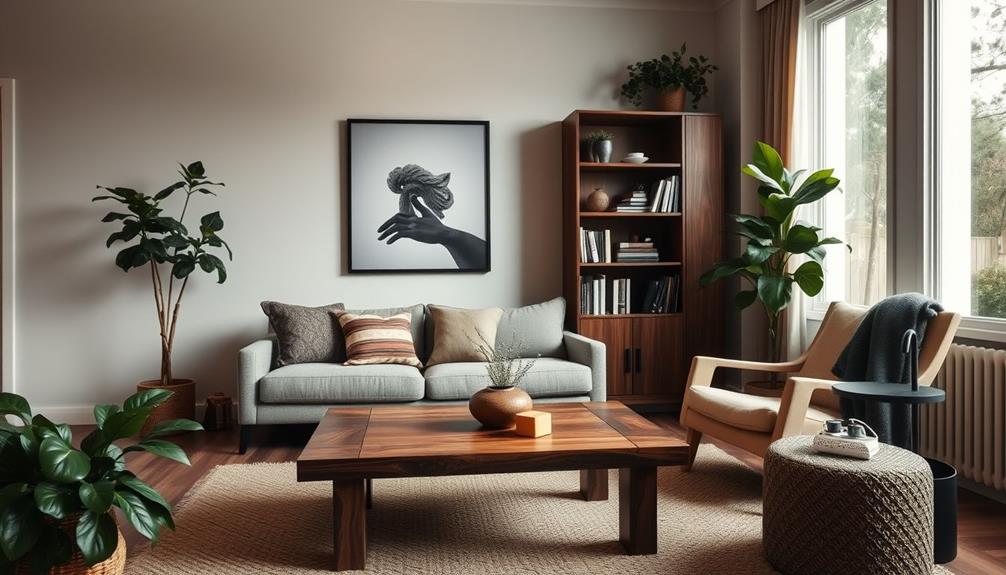To break into the interior design industry, start by evaluating your skills and interests. Consider pursuing a degree, preferably a bachelor's, from an accredited program. Gain hands-on experience through internships or assistant roles to build your portfolio. You'll also need to become familiar with essential design software and industry trends. Certification, like passing the NCIDQ exam, can enhance your credibility. Network at design events and join professional organizations to connect with others in the field. Keep your portfolio updated to showcase your best work and style. There's more to discover about finding your path in this creative industry. One key aspect of breaking into the interior design industry is staying abreast of interior design business growth strategies. This includes understanding market trends, marketing techniques, and financial management. Additionally, developing a strong online presence through a professional website and social media can help you attract clients and showcase your work. Remember, success in interior design requires a combination of creativity and business acumen. Immersing yourself in both aspects will set you up for a successful career in the industry.
Key Takeaways
- Pursue a degree in Interior Design or a related field, ensuring it's accredited by the Council for Interior Design Accreditation (CIDA).
- Gain hands-on experience through internships, volunteering, and entry-level positions to build a robust portfolio.
- Pass the NCIDQ exam after obtaining your degree to become a certified interior designer.
- Develop essential skills such as creativity, communication, and proficiency in design software like AutoCAD and SketchUp.
- Build a professional network by attending industry events, joining associations, and engaging with experienced designers for mentorship.
Self-Assessment and Career Goals

When considering a career in interior design, it's crucial to start with a self-evaluation to understand your unique skills and interests. This means determining whether your passion leans more toward residential interiors or commercial interior design. Knowing your preference will help you shape your career goals and specialization in the industry.
Set both short-term and long-term career goals while remaining flexible. The interior design field evolves quickly, and staying open to new opportunities can enhance your journey.
Engaging in internships during your interior design education is critical; these practical experiences provide hands-on exposure and help you build a strong portfolio that showcases your design skills.
As you progress, keep an eye on industry trends. The ability to adapt and incorporate fresh ideas into your work can set you apart in a competitive market.
Educational Pathways and Degrees

Pursuing a career in interior design requires a thoughtful approach to education, as the right degree can considerably impact your future opportunities. A bachelor's degree in interior design typically involves four years of study, covering important topics like design theory and color theory.
If you're looking for a quicker route, an associate's degree offers a two-year pathway into the field, but keep in mind that many states require a formal degree or certificate to practice.
Choosing accredited interior design programs is essential; look for those recognized by the Council for Interior Design Accreditation (CIDA) to guarantee quality education. Notable institutions include the University of Cincinnati and Cornell University.
After completing your degree, you'll likely need to pass the National Council for Interior Design Qualification (NCIDQ) exam for certification.
Internships play a significant role in gaining practical experience. Requirements for work hours can vary depending on whether you pursue a bachelor's or associate's degree.
Essential Skills for Designers

Interior designers need a diverse skill set to turn their creative visions into reality. Strong creativity and artistic ability are fundamental for developing innovative design concepts that meet client preferences. Proficiency in design software like AutoCAD, SketchUp, and Revit is critical for creating detailed plans and visualizations, which help bring your ideas to life.
Excellent communication skills are necessary for effectively conveying design ideas to clients and collaborating with contractors and vendors. When you can articulate your vision clearly, you'll foster better relationships with design professionals and guarantee everyone is on the same page.
Attention to detail is another key skill; it guarantees high-quality execution and helps you avoid costly mistakes during the implementation phase. Time management is essential for your interior design career, allowing you to meet project deadlines while juggling multiple tasks efficiently.
Whether you're managing a small renovation or a large-scale project, mastering project management techniques will keep you organized and on track. By honing these fundamental skills, you'll not only build a portfolio that showcases your talent but also set yourself up for success in this competitive industry.
Building Professional Networks

How can you build a strong professional network in the interior design industry? Start by attending design events, workshops, and trade shows to connect with industry professionals. These gatherings offer invaluable insights into current trends and opportunities.
You should also consider joining local design associations like ASID or IIDA. They provide essential networking resources, professional development events, and potential job leads. Utilize platforms like LinkedIn to build your professional profile, engage with design groups, and seek mentorship from established designers.
Participating in community projects or pro bono work is another excellent way to build your portfolio while expanding your network through collaboration. Informational interviews with experienced interior designers can help you gain insights and establish relationships that could lead to future opportunities.
Here's a quick overview of networking approaches:
| Networking Approach | Benefits | Action Items |
|---|---|---|
| Attend Design Events | Connect with industry pros | Research upcoming events |
| Join Local Design Associations | Access job leads and resources | Sign up for a membership |
| Engage with Design Groups | Gain mentorship and advice | Join discussions online |
| Participate in Community Projects | Build portfolio and network | Volunteer for a local project |
| Conduct Informational Interviews | Establish valuable relationships | Reach out to designers |
Certification and Licensing Requirements

Building a solid professional network in the interior design industry is just one step toward establishing your career. To truly succeed, you need to navigate the certification and licensing requirements specific to your state. Many states mandate that interior designers hold a license, often requiring a degree from an accredited program recognized by the Council for Interior Design Accreditation (CIDA).
To qualify for the National Council for Interior Design Qualification (NCIDQ) exam, you'll need at least a bachelor's degree in interior design and two years of supervised work experience. The NCIDQ exam consists of three sections: the Interior Design Fundamentals Exam (IDFX), the Interior Design Professional Exam (IDPX), and the Practicum Exam, each focusing on essential areas like design development and project completion.
Once certified, maintaining your status often involves ongoing education. Many jurisdictions require continuing education units (CEUs) to guarantee you're up-to-date on industry trends and standards.
Joining professional organizations like the American Society of Interior Designers (ASID) can also provide valuable resources and support regarding certification and licensing requirements, enhancing your journey as an interior designer.
Staying Updated With Industry Trends

Staying ahead in the ever-evolving field of interior design requires a proactive approach to industry trends. To guarantee you're always in the know, commit to regularly reading industry publications like "Interior Design" and "Architectural Digest." These resources will keep you informed about the latest trends and influential designers shaping the field.
Additionally, attending trade shows and design expos, such as the International Contemporary Furniture Fair (ICFF), offers invaluable networking opportunities and exposure to new materials and technologies. Participate in continuing education units (CEUs) and workshops that focus on emerging trends, especially sustainable design practices, to enhance your skills.
Engage with influential designers and firms on social media platforms like Instagram and Pinterest to gain fresh insights into current styles. Finally, consider joining professional organizations like the American Society of Interior Designers (ASID) for access to essential resources and updates on industry standards.
Here's a quick overview of ways to stay updated:
| Resource Type | Examples | Benefits |
|---|---|---|
| Industry Publications | Interior Design, Architectural Digest | Latest trends and products |
| Trade Shows | ICFF, NeoCon | Networking opportunities |
| Continuing Education | Workshops, CEUs | Skills enhancement |
Conclusion
In summary, breaking into the interior design industry may seem intimidating, but it's all about your passion and persistence. Many successful designers started with little more than a love for aesthetics and a willingness to learn. By evaluating your goals, pursuing education, honing your skills, and networking, you'll carve out your own path. Remember, the journey is just as important as the destination, and each step you take brings you closer to your dream career.









